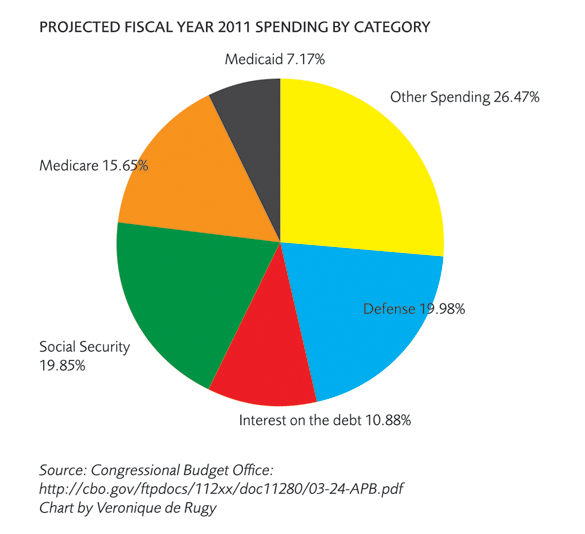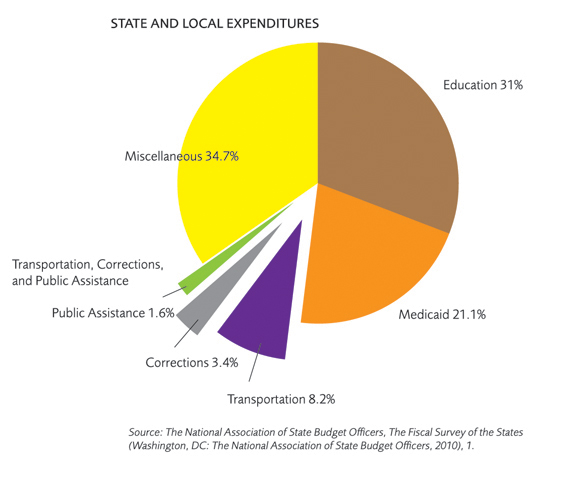- | Government Spending 101 Government Spending 101
- | Government Spending Government Spending
- | Research Papers Research Papers
- |
Where do governments spend money?
Governments make direct purchase of goods and services. The federal government, for example, buys guns, bullets, tanks, and uniforms, etc. and pays soldiers to supply the national defense.
The Congress shall . . . provide for the common Defence and general Welfare of the United States.
The Constitution of the United States, Article I, Section 8
Governments make direct purchase of goods and services. The federal government, for example, buys guns, bullets, tanks, and uniforms, etc.and pays soldiers to supply the national defense. Governments also make “transfer payments” such as welfare, Social Security, Medicare, Medicaid, and unemployment insurance.
Federal Expenditures
Federal expenditures fall into five main categories: health insurance (Medicaid and Medicare), retirement benefits (Social Security), national defense, interest on the debt and "other spending" (a broad category that covers spending on education, housing, transportation, agriculture, etc.).

Medicare and Medicaid
The Medicare program is health insurance for the elderly. Beginning at age 65, eligible beneficiaries get much of their medical care covered by taxpayer funds. Medicaid is government health insurance for the poor. Medicare and Medicaid together accounted for almost 22 percent of the federal budget in 2009.
Social Security
Approximately 23 percent of federal expenditures in 2009 went to Social Security benefits. In the projected budget for 2011, 19.1 percent of federal expenditures are slated to go to social security.
National Defense
In 2009, defense spending represented 18.8 percent of the federal government’s overall spending. In 2011, defense spending is supposed to form about of the budget.
Other Spending
The federal government spends money in several other areas as well. For example, it sends money to the states to fund various programs and gives cash benefits to the unemployed. Then there is earmark or "pork" spending, spending that benefits the residents of a particular congressman’s district but that has tenuous benefits, if any, for the rest of the country. Examples include transportation projects, subsidies for local industries, museums, flood control, and economic development.
Interest on the Federal Debt
A final, crucial, but seldom discussed component of federal spending is the payment of interest on the federal debt. This comprised 5.3 percent of spending in 2009.

State and Local Expenditures

Education
Roughly 31 percent of state expenditures go to education. Of this 21.1 percent goes to elementary and secondary education, while 9.8 percent goes to higher education.
Medicaid
Like the federal government, the states devote a sizeable proportion of their spending to Medicaid. In fact in fiscal year 2009, 21.1 percent of state spending went to Medicaid.
Transportation, Corrections, and Public Assistance
In fiscal year 2009, approximately 8.2 percent of state spending went to transportation, 3.4 percent went to corrections, and 1.6 percent went to public assistance.
Miscellaneous
In addition to the main items discussed so far, state spend money in a variety of smaller categories, including sports and culture (museums, skating rinks, zoo, stadiums, and parks), energy subsidies, housing, and more. “All other expenditures,” 34.9 percent of state spending in 2009, covers this miscellaneous spending as well as the amount states spend on compensation for current and former employees, including payments for pensions.

